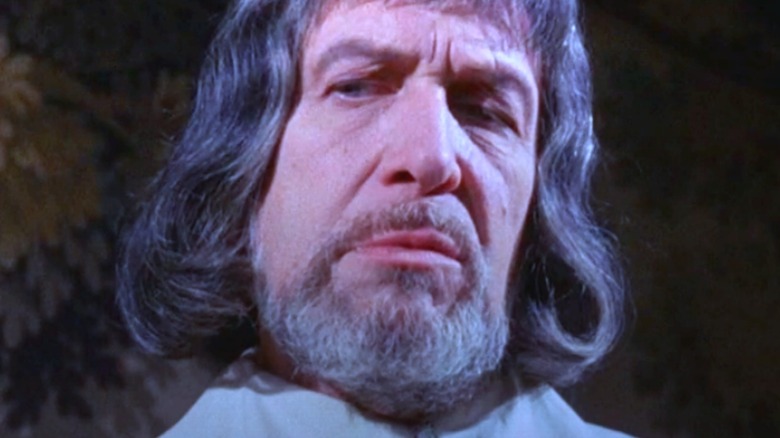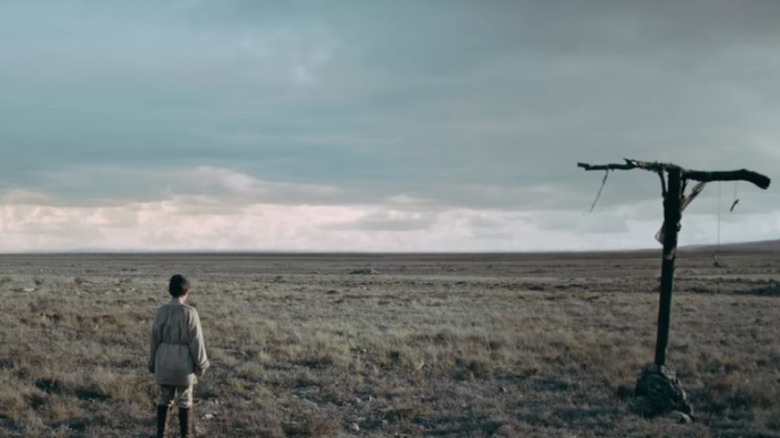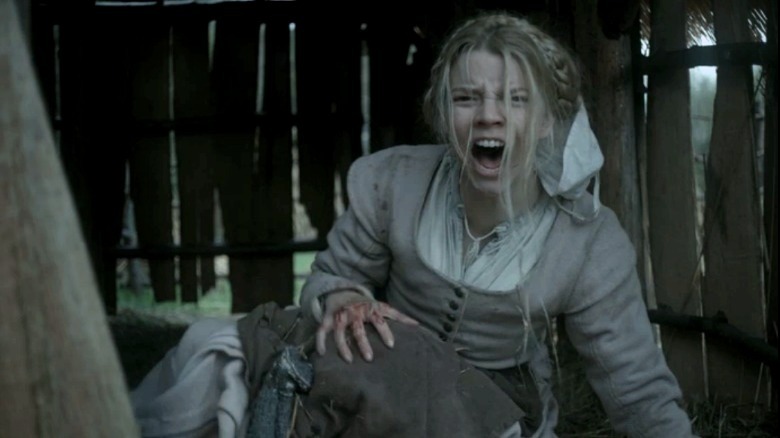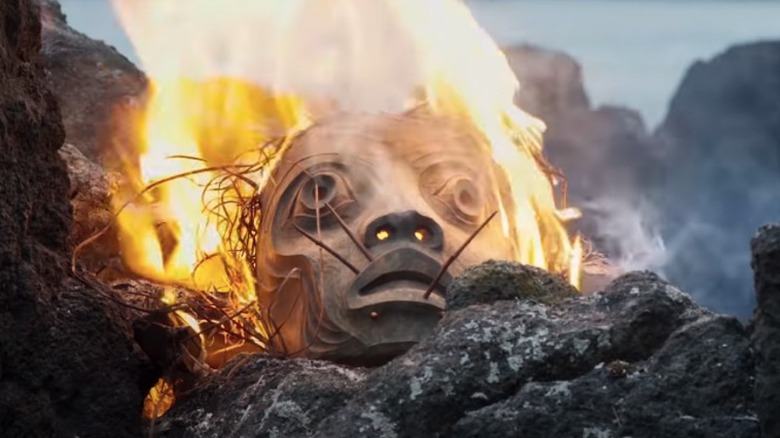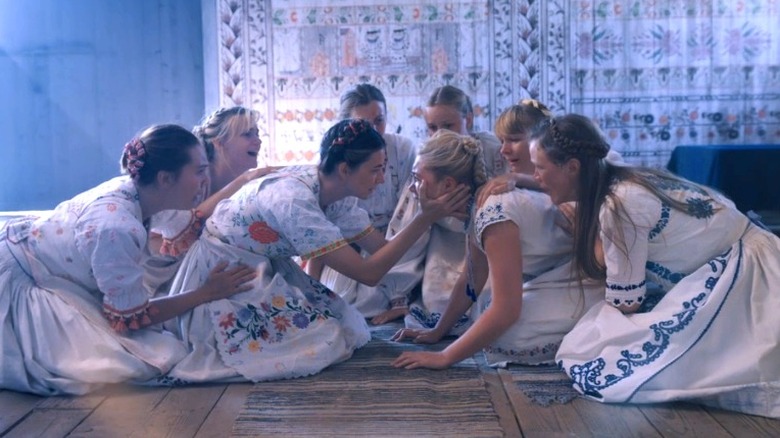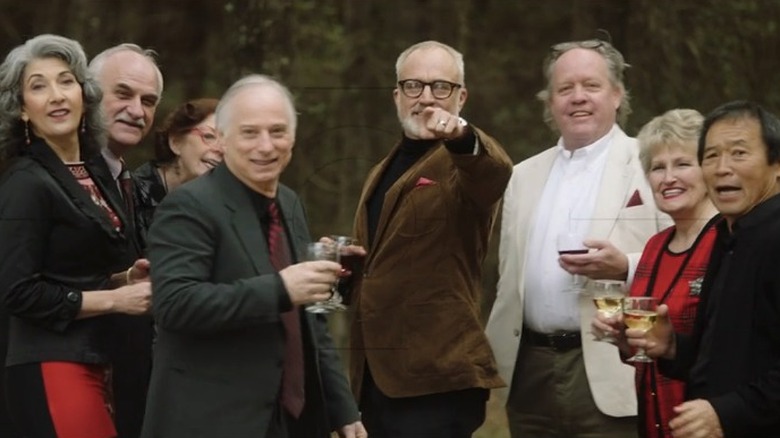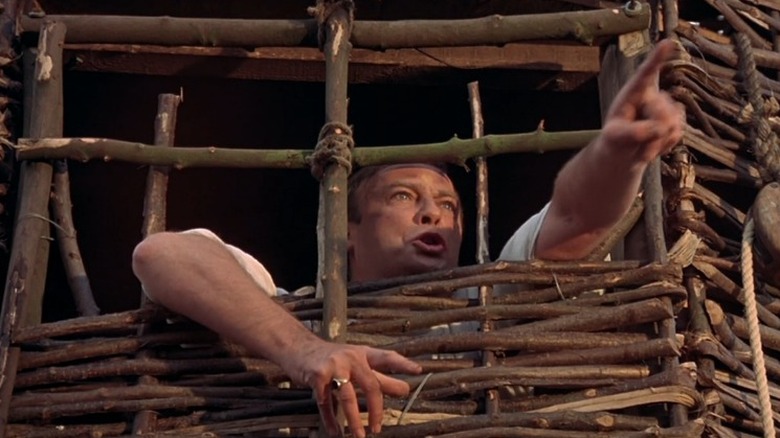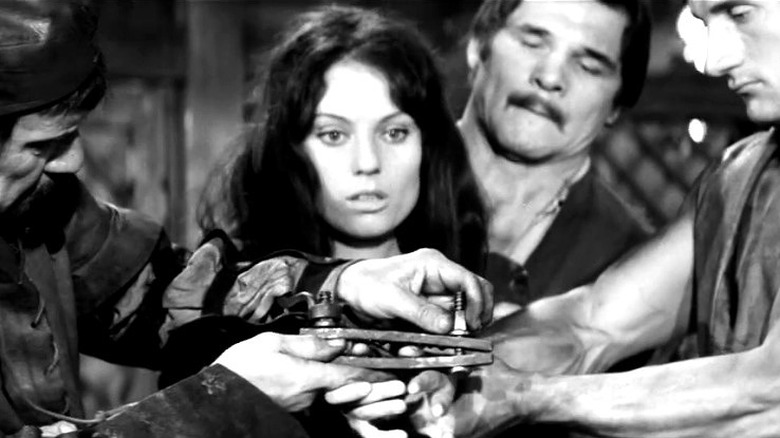Folk Horror Is The Genre We Need Right Now, And Here's Where To Start Watching
In "We Don't Go Back: A Watcher's Guide to Folk Horror," author Howard David Ingham explains his title — and the bit of dialogue that inspired it — as follows: "An exchange in which reason faced off against the old ways, pagan superstitions, old beliefs. We investigate. We divine the rules, discard the old, and make new rules. But we don't go back" (Ingham, 2018, p.7).
Except — and this is partially Ingham's point — we actually do "go back" all the time, in ways that range from the nostalgic and innocuous (e.g., fashion trends, the nouveau witch, Twitter spiritualism) to the horrifying and regressive (e.g., the rise in neo-Nazism, hate speech and legislation, and white supremacy). The push-and-pull between tradition and progress, superstition or religion and science, status quo and transition, is, Ingham suggests, the driving force behind the recently defined (though centuries old) sub-genre of folk horror. And just as the political tumult, anxieties, fears, sorrows, and frustrations of the 1960s and 1970s birthed a genre-defining cinematic interest in folk horror, our contemporary ambivalence toward technology — and our increased awareness of the pervasive inhumanity of humanity — has reignited a necessary interest in these stories.
But it isn't just the genre's ability to comment on our pull toward the ghosts of our past (both literal and metaphoric) that makes it worthy of our attention. In addition, by being reflective and revealing, folk horror carves out a much-needed space for up-and-coming artists and cinematic innovation, and allows us to connect across cultures, generations, and identities.
What we talk about when we talk about folk horror
Importantly, folk horror is at once specific and versatile in the characteristic means by and through which it explores its themes. Though we have the 2010 BBC Four special "A History of Horror" to thank for popularizing the term, author Adam Scovell's "Folk Horror, Hours Dreadful and Things Strange" provides a more detailed definition of the genre. The first element of Folk Horror, he writes, is "[a landscape] where elements within its topography have adverse effects on the social and moral identity of its inhabitants" (Scovell, 2017, p. 17). Robert Eggers' "The VVitch," with its isolated, Puritanical New England village, is an excellent contemporary example of this, as are Valdimar Jóhannsson's "Lamb," Emma Tammi's "The Wind," and David Casademunt's "The Wasteland" (aka "The Beast," aka "El páramo").
Scovell's second element of folk horror deals with a requisite halting or regression of social progress, or what he calls "skewed belief systems and morality" (see: the human sacrifice in Ari Aster's "Midsommar," the deadly dogma of "Children of the Corn," or the mere title of Christopher Alender's "The Old Ways"). In folk horror, these beliefs inevitably lead to Scovell's third element of the genre, a "happening/summoning," as he dubs it (Scovell, 2017, p. 18). In other words, the film's climax, which involves a violent or terrifying confrontation between the opposing views of morality. This definition is important, and integral to the contemporary benefits of the genre.
Folk horror is a safe space for fresh talent and ideas
A first time director with meagre financing — like George A. Romero was, when he changed cinema forever with "Night of the Living Dead" — would never be given the keys to, say, a Marvel movie. Unfortunately, in 2022, they're all Marvel movies (even the ones that aren't, like whatever the heck "Morbius" was), and as both Jodie Foster and Roland Emmerich have famously noted (per Den of Geek), it's becoming harder and harder for fresh writers and directors to see their original stories realized on the silver screen. Thus, it's up to horror to serve as a safe space — perhaps the last safe space outside of documentary — in which fledgling artists might actually flourish. Folk horror, with its reliance on landscape and tension as opposed to fantastic beasts and bombastic visuals, is uniquely qualified to provide a space even more expansive and varied than other modes of horror.
The budget-draining CGI, special effects, multiple sets, and big name-cluttered ensemble casts required to create big, episodic, formulaic franchise films have no place whatsoever in a narrative driven entirely by atmosphere and dread. It was folk horror that gave us ground-breaking directors like Bill Gunn (in the 1970s, with "Ganja & Hess") and Kasi Lemmons (in the 1990s, with "Eve's Bayou"), folk horror that gave us our first widely-viewed found footage horror film ("The Blair Witch Project"), folk horror that introduced us, more recently, to the likes of Debra Granik, Robert Eggers, Ari Aster, Jennifer Kent, Alice Lowe, Ben Wheatley, Chad Crawford Kinkle, Lukas Feigelfeld, Karyn Kusama, and so, so many more horror directors too numerous to name, and it will be folk horror that saves us not only from our comic book-induced coma, but ultimately (if ironically) from ourselves.
It's a Folk Horror world (after all)
Folk Horror exists, in some form, in the narrative traditions of every culture around the world. Like fairytales, mythologies, religious parables, and fables, folklore is one of the means by which a populations' ancestors explained and informed the world around them. In "The Witcher" books, Andrzej Sapkowski makes frequent use of a range of European folk tales (via Lithub), including the ancient Slavic leshy — a reminder that folk horror is a bridge between our love of Just World-serving fantasy and our need to acknowledge the not-so-just world we inhabit.
But folk horror isn't limited to the Western literary and cinematic tradition.
Nonzee Nimibutr and Wisit Sasanatieng's "Nang Nak" is a chilling, deeply sad must-see based on a Thai folk legend. "The Wailing," from South Korea's Na Hong-jin, puts a crime thriller twist on the genre. Both Hideo Nakata's "Ringu" and Takashi Shimizu's "Ju-On" (re-made and re-named as "The Ring" and "The Grudge") explore the Japanese notion of the Yokai, while director Mattie Do's Vientiane-based "Nong Hak" ends on an ambiguous note — an approach that permeates the folk horror tradition. Then there's legacy of violence, horror, and oppression found in films that grapple with the colonial attempt to co-opt or snuff-out indigenous cultures (a theme embedded in the folk horror of several continents and countries, including the Americas and Australia), and the importance of films such as Gwaai Edenshaw and Helen Haig-Brown's "SGaawaay K'uuna," the first feature film to be told entirely in Haida dialects (via Toronto Now). More so than any other genre or storytelling mode, folk horror allows us to relate to identities and traditions other than our own — for good reason, and to the benefit of us all.
Folk Horror is reflective, revealing, and unifying
In Pavol Prokop's examination of Universal Human Fears (University of Trnava), he explores the ancient threats our brains remain hung-up on, including strangers and the fear of leaving the safety of home. If we view these anxieties through the lens of folk horror, the relevance and shared experience of these amygdala-driven fears becomes more apparent.
Folk horror frequently deals with a stranger in a strange place, a character becoming strange to themselves via transformation (as in Erik Blomberg's "The White Reindeer," or the cross-cultural vampire narrative), or a character being violently torn from their home and existence through death (see, again, the Yokai).
However, the genre explores our fear of "leaving home" in ways that are less straightforward as well, and ultimately more revealing. If we imagine "home" and "safety" as less of a place and more a mode of being — including the belief systems attached to that mode of being — the compulsion to seek safety in those outdated beliefs, the nostalgia for an era that never actually existed, or the fear of anyone whose lived experience differs from our own, all reveal themselves to be, to varying extents, a horrifying, animalistic "flight" response. If we're able to recognize that response not only in ourselves, but in others, we might finally begin to see the many ways in which, far from keeping us safe, it poses a universal threat to our species.
So, when it comes to diving into this genre's best films, where do we begin?
Where to begin your folk horror journey
Fans of the genre are no doubt wondering why we've yet to mention the "unholy trinity" of folk horror films, as described by Film School Rejects. Those are: Robin Hardy's "The Wicker Man" (1973), Piers Haggard's "The Blood on Satan's Claw" (1971), and Michael Reeves' "Witchfinder General" (1968). The films are all, inarguably, excellent places to begin, particularly since they so heavily inform contemporary Western folk horror. It's not difficult, for instance, to see elements of "The Wicker Man" in Aster's "Midsommar," "Ben Wheatley's shocking "Kill List," or Jordan Peele's "Get Out." Peele substitutes the white, wealthy suburbs for a remote island village, but his Black protagonist's isolation is no less palpable for it.
As for "The Blood on Satan's Claw," its exposure of our fear of youth and female sexuality permeates too many films to name, including Fritz Böhm's "Wildling." Finally, the fact that "Witchfinder General" — a film inspired by the historic, government-approved, 17th century torture and persecution of "witches" — is as relevant in 2022 as it was when it came out amidst the Women's Movement almost (almost) goes without saying.
View these films in conjunction with Kier-La Janisse's extensive and exquisite documentary, "Woodlands Dark and Days Bewitched: A History of Folk Horror," and you've got yourself a veritable Folk Horror 101. Importantly, in addition to speaking to the political tensions and social anxieties of the late 1960s and early 1970s, these three, decades-old films remind us that while time may be linear, progress is not.
Folk horror's ambiguity keeps it relevant
"The Wicker Man," for instance, is dripping with the era's liberally-aligned, back-to-the-land, new age spiritualist movement (all of which were in response, as they are today, to an increasing mistrust of the establishment, per The Atlantic), but at the same time, the film (and particularly its ending) depicts this return to "the old ways" with some ambivalence. On the one hand, the film's conservative Christian cop protagonist (who gets sacrificed) is wholly unlikeable, and blind to the ways in which the dogma of his religion is just as folkloric as the villagers' pagan beliefs. On the other, the village's leader implies he knows a human sacrifice won't bring the crops back: He's simply doing it to appease the people, and in a sense, contribute to his own ethos. In the end, he's just like any other scheming politician, while his seemingly enlightened followers have allowed their own dogma to justify murder.
It's an "and yet ..." ending that speaks with still-blinding relevance to a contemporary society both connected and informed — and torn apart and misinformed — by a technology upon which we're increasingly dependent. And just as gothic horror laid bare the Victorian era's xenophobia, fear of female power, and anxieties about the Industrial Revolution, folk horror exposes, in ways both varied and versatile, our so-called modern society's eternally fraught relationship to progress, lack of cross-cultural or cross-experiential empathy, and cyclical and reactionary resistance to change. For this reason, it's not entirely necessary to embrace the genre from any one particular starting point versus another.
Folk Horror: the most untethered horror of them all
Allowing "Get Out" to inform "The Wicker Man," Karyn Kusama's "Jennifer's Body" to inform "The Blood on Satan's Claw," or Otakar Vávra's "Witchhammer" (a 1970 Czech film) to inform 1968's "Witchfinder General" (and not, in all three cases, the other way around) reiterates the various films' connective tissue in ways both unexpected and revealing. (Another benefit of the genre: it's essentially inexhaustible thanks to its malleable thematic functionality). Similarly, viewing Kaneto Shindô's "Onibaba" (1964) or Norio Tsuruta's "Kakashi" (2001), in conjunction with and relation to, for instance, Nietzchka Keene's "The Juniper Tree" (1990) or John and Zelda Adams and Toby Poser's "Hellbinder" (2021) puts an even finer point on the universality of the fears and anxieties each film explores.
Folk horror has no real starting point, middle, or "current" agenda, since its focus on such simultaneously ancient and eternally present human and societal tensions allows it to exist (ironically, for a genre concerned with "tradition") untethered to any one particular time or space. While an individual narrative's purpose might well be to remind us that "we don't go back," it also — as an overarching mode of storytelling — can't help but reveal the illusory nature of a notion like "going back." For all our seeming progress, for all our advances in technology and science, as both viewers and the very "folk" from whence the narrative tradition takes its name, we are — as Haggard's skeptical Man of Science suggests — "bent on reviving forgotten horrors."
